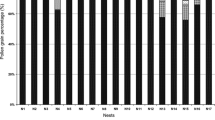Summary
The foraging behavior of the pollinators of tristylous Pontederia cordata was studied to determine if differences in floral morphology would lead to preferential visitation of the floral morphs. Although nectar production is not different in the three floral morphs, differences in the production and size of pollen grains produced by the three anther levels results in the morphs offering variable amounts of resources to pollen-collecting insects. Bumblebees (Bombus spp.) and the solitary bee Melissodes apicata used P. cordata primarily as a nectar source and therefore did not seem to exhibit any morph preference. In contrast, honeybees visited flowers mainly for pollen and preferred to forage on long-level anthers of the short-and mid-styled morphs. An analysis of the composition of corbicular pollen loads indicated that, relative to the frequency of production in the population: 1) honeybees collected an excess of pollen from long-level anthers; 2) bumblebees collected the three types of pollen without any apparent preference; and 3) M. apicata preferentially collected pollen from the short-level anthers — presumably because their proboscides are modified by the presence of tiny hairs. The results suggest that P. cordata in Ontario is serviced by a diverse, unspecialized pollinator fauna which is not co-adapted to the tristylous floral polymorphism.
Similar content being viewed by others
References
Barrett SCH, Anderson JM (1985) Variation in expression of trimorphic incompatibility in Pontederia cordata L. (Pontederiaceae). Theor Appl Genet 70:355–362
Barrett SCH, Glover DE (1985) On the Darwinian hypothesis of the adaptive significance of tristyly. Evolution 39:766–774
Barrett SCH, Wolfe LM (1986) Pollen heteromorphism as a tool in studies of the pollination process in Pontederia cordata L. In: Mulcahy DL, Bergamini Mulcahy G, Ottaviano E (eds) Biotechnology and Ecology of Pollen. Springer Berlin Heidelberg New York pp 435–442
Barrett SCH, Price SD, Shore JS (1983) Male fertility and anisoplethic population structure in tristylous Pontederia cordata (Pontederiaceae). Evolution 37:745–759
Charlesworth D (1979) The evolution and breakdown of tristyly. Evolution 33:489–498
Darwin C (1877) The different forms of flowers on plants of the same species. John Murray, London
Dulberger R (1970) Tristyly in Lythrum junceum. New Phytol 69:751–759
Ennos RA (1981) Quantitative studies of the mating system in two sympatric species of Ipomoea (Convolvulaceae). Genetica 57:93–98
Ganders FR (1979) The biology of heterostyly. New Zealand J Bot 17:607–635
Glover DE, Barrett SCH (1983) Trimorphic incompatibility in Mexican populations of Pontederia sagittata Presl. (Pontederiaceae). New Phytol 95:439–455
Harding J, Mankinen CB (1967) Genetics of Lupinus. I. Variations in flower color from natural populations of Lipinus nanus. Canad J Bot 45:1831–1836
Laberge WE (1956) A revision of the bees of the genus Melissodes in North and Central America. Part II. (Hymenoptera, Apidae). The University of Kansas Science Bulletin 38:533–578
Mulcahy DL, Caporello D (1970) Pollen flow within a tristylous species, Lythrum salicaria. Am J Bot 57:1027–1030
Ornduff R (1966) The breeding system of Pontederia cordata L. Bull Torr Bot Cl 93:407–416
Ornduff R (1971) The reproductive system of Jepsonia heterandra. Evolution 25:300–311
Ornduff R (1975) Pollen flow in Lythrum junceum, a tristylous species. New Phytol 75:161–166
Price SD, Barrett SCH (1982) Tristyly in Pontederia cordata (Pontederiaceae). Can J Bot 60:897–905
Price SD, Barrett SCH (1984) The function and adaptive significance of tristyly in Pontederia cordata L. (Pontederiaceae). Biol J Linn Soc 21:315–329
Primack RB, Silander JA Jr (1975) Measuring the relative importance of different pollinators to plants. Nature 255:143–144
Schemske DW, Horvitz CC (1984) Variation among floral visitors in pollination ability: a precondition for mutualism specialization. Science 225:519–521
Stanton ML (1987) Reproductive biology of petal color variants in wild populations of Raphanus sativus: I. Pollinator response to color morphs. Am J Bot 74:178–187
Thomson JD, Stratton DA (1985) Floral morphology and crosspollination in Erythronium grandiflorum (Liliaceae). Am J Bot 72:433–437
Waser NM, Price MV (1981) Pollinator choice and stabilizing selection for flower color in Delphinium nelsonii. Evolution 35:376–390
Weller SG (1981) Pollination biology of heteromorphic populations of Oxalis alpina (Rose) Knuth (Oxalidaceae) in southeastern Arizona. Bot J Linn Soc 83:189–198
Wolfe LM (1985) The pollination dynamics of Pontederia cordata L. (Pontederiaceae). M.Sc. thesis. University of Toronto. p 129
Author information
Authors and Affiliations
Rights and permissions
About this article
Cite this article
Wolfe, L.M., Barrett, S.C.H. Pollinator foraging behavior and pollen collection on the floral morphs of tristylous Pontederia cordata L.. Oecologia 74, 347–351 (1987). https://doi.org/10.1007/BF00378928
Received:
Issue Date:
DOI: https://doi.org/10.1007/BF00378928




